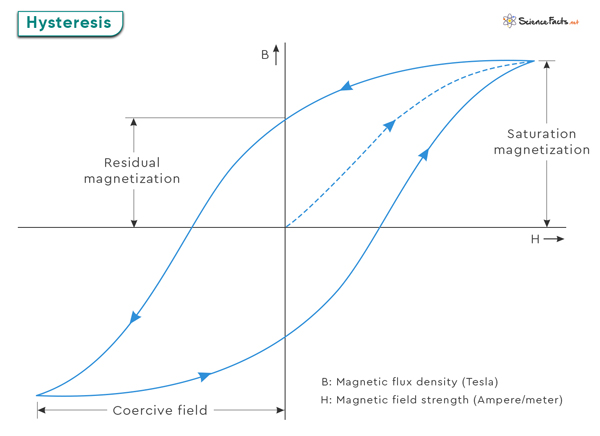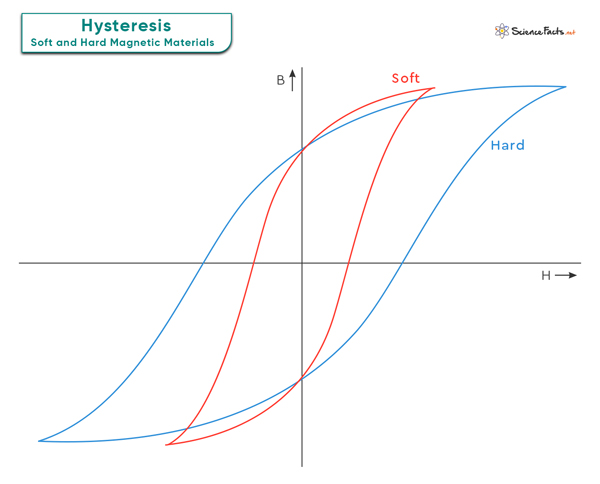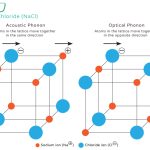Hysteresis
Hysteresis is a concept that refers to the lag between the input and output of a system, particularly concerning changes in temperature, pressure, or magnetic fields. When a magnetic material is subjected to an external magnetic field, its atomic and molecular dipoles align with the applied field. This alignment results in the material becoming magnetized. However, when the external field is removed, some materials lose their magnetism almost entirely, while others retain a significant portion.
Magnetic hysteresis is the property of a material to retain a certain level of magnetization even after the external magnetic field has been removed. Hysteresis helps us understand a material’s magnetic properties and how it retains magnetization even after removing the external magnetic field.
Hysteresis is essential as it provides valuable insights into the behavior and properties of various materials. By studying hysteresis, scientists and engineers can better understand how materials respond to external stimuli and make informed decisions in designing and utilizing them for various applications while considering energy loss, stability, and reliability.
Magnetization and Demagnetization
Magnetization refers to aligning the magnetic domains within a material to create a magnet. It can be achieved by exposing the material to a strong magnetic field, causing the magnetic domains to align in the same direction. The material becomes magnetized and exhibits magnetic properties.
On the other hand, demagnetization is the process of removing or reducing the magnetization of a material. It can be done by subjecting the magnetized material to an opposing magnetic field, heating it beyond its Curie temperature (the temperature at which a material loses its magnetic properties), or mechanically shaking it. Demagnetization results in the loss of magnetic properties in the material, returning it to its original state or a non-magnetic state.
Hysteresis Loop
A hysteresis loop, also known as a hysteresis or magnetization curve, is a graphical representation of the hysteresis behavior. It illustrates the relationship between the magnetic flux density and the externally applied magnetic field strength. The flux density is plotted along the vertical axis. It is represented by the symbol B and has the unit of Tesla or T. The magnetic field strength is plotted along the horizontal axis. It is represented by the symbol H with the unit of Ampere per meter or A/m. The curve typically forms a closed loop, showing how the magnetization changes as the magnetic field strength increases and decreases. Magnetic saturation is achieved when the flux density reaches its limit.
By analyzing the shape and size of the hysteresis loop, scientists and engineers can understand and predict how a material will behave in different magnetic conditions. This information is crucial in various applications.
Retentivity and Coercivity
Two important properties associated with hysteresis are retentivity and coercivity. Retentivity, also known as remanence or residual magnetism, refers to the ability of a material to retain its magnetization even in the absence of an external magnetic field. It measures the material’s “stickiness” when holding on to its magnetic properties.
On the other hand, coercivity is the measure of the resistance of a material to changes in its magnetization. The coercive field represents the strength of the external magnetic field required to demagnetize the material thoroughly. A material with high coercivity requires a stronger external field to remove its magnetization. In contrast, material with low coercivity can be easily demagnetized.
The hysteresis loop provides valuable information about the retentivity and coercivity of a material.
Soft and Hard Magnetic Materials
Hysteresis loops play a crucial role in designing various electrical devices that undergo rapid changes in magnetism or require data storage capabilities. Knowing the difference between soft and hard magnetic materials is essential.
Soft magnetic materials are characterized by smaller and narrower hysteresis loops. They are valuable in electrical machinery, aiming to minimize energy loss. This advantage is especially evident in transformers and motor cores, where reduced heat dissipation enhances efficiency.
Hard magnetic materials are characterized by larger hysteresis loops and exhibit greater retentivity and coercivity. This property makes them ideal for applications involving permanent magnets, where preventing demagnetization is essential. Additionally, hard magnetic materials find utility in memory devices like audio recording equipment, computer disk drives, and credit cards. Their high coercivity ensures that stored data remains intact and is not easily erased.
Hysteresis Loss
Hysteresis loss refers to the energy dissipation phenomenon in materials exhibiting magnetic hysteresis. When an external magnetic field is applied to a material, the magnetic domains within the material align themselves with the direction of the applied field. However, not all domains can align perfectly due to various factors, such as imperfections in the material’s crystal structure, thermal vibrations, and magnetic domain wall movements.
As a result, when the external magnetic field is removed, some magnetization remains in the material. This residual magnetization must be overcome by demagnetizing the material thoroughly. The energy required to do this work dissipates as heat, resulting in hysteresis loss.
The magnitude of hysteresis loss depends on several factors, including the magnetic properties of the material, frequency of the applied magnetic field, and temperature. Materials with high coercivity and high retentivity tend to exhibit higher hysteresis losses. Reducing hysteresis loss is essential in applications such as transformers and electric motors, where efficiency is crucial.
Applications
Hysteresis finds wide-ranging applications across various fields of science and technology. Here are some of the critical applications in different domains:
1. Electrical engineering: Hysteresis is used to design electrical devices such as relays, transformers, and magnetic sensors. It helps in controlling the switching behavior and stability of these devices.
2. Material science: Hysteresis is commonly observed in the behavior of materials, particularly in ferromagnetic materials. This property is exploited in magnetic memory devices (hard drives), magnetic shielding, and magnetic actuators.
3. Control systems: Hysteresis is utilized in control systems to prevent rapid and erratic switching between different states. It helps to provide stability and prevent oscillations in control systems.
4. Mechanics: Hysteresis can be found in mechanical systems with a delay or lag between the applied force and the resulting displacement. This property is used in shock absorbers, dampers, and mechanical switches.
-
References
Article was last reviewed on Wednesday, October 11, 2023








